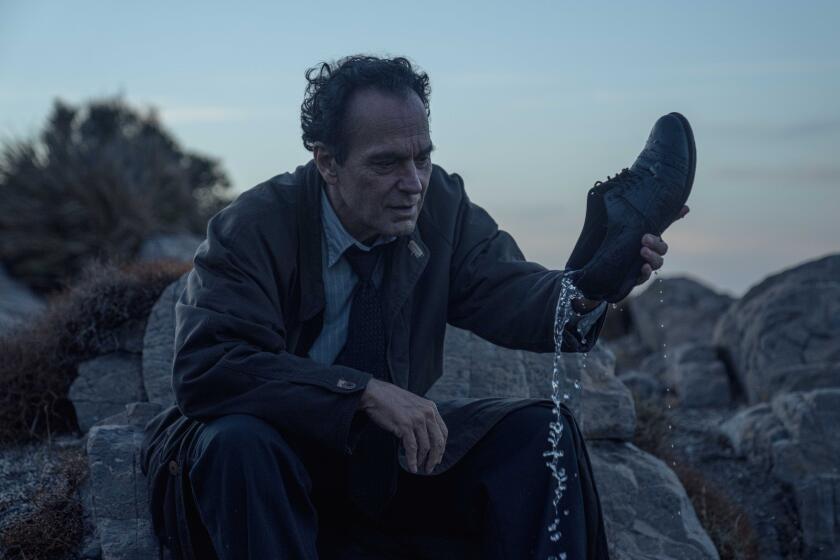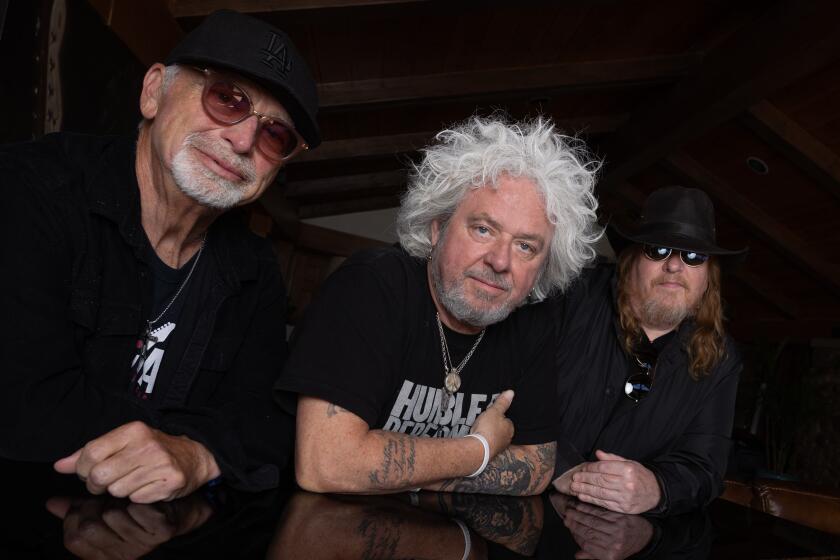Newsletter: An art park fundraiser aims to revitalize an olive grove
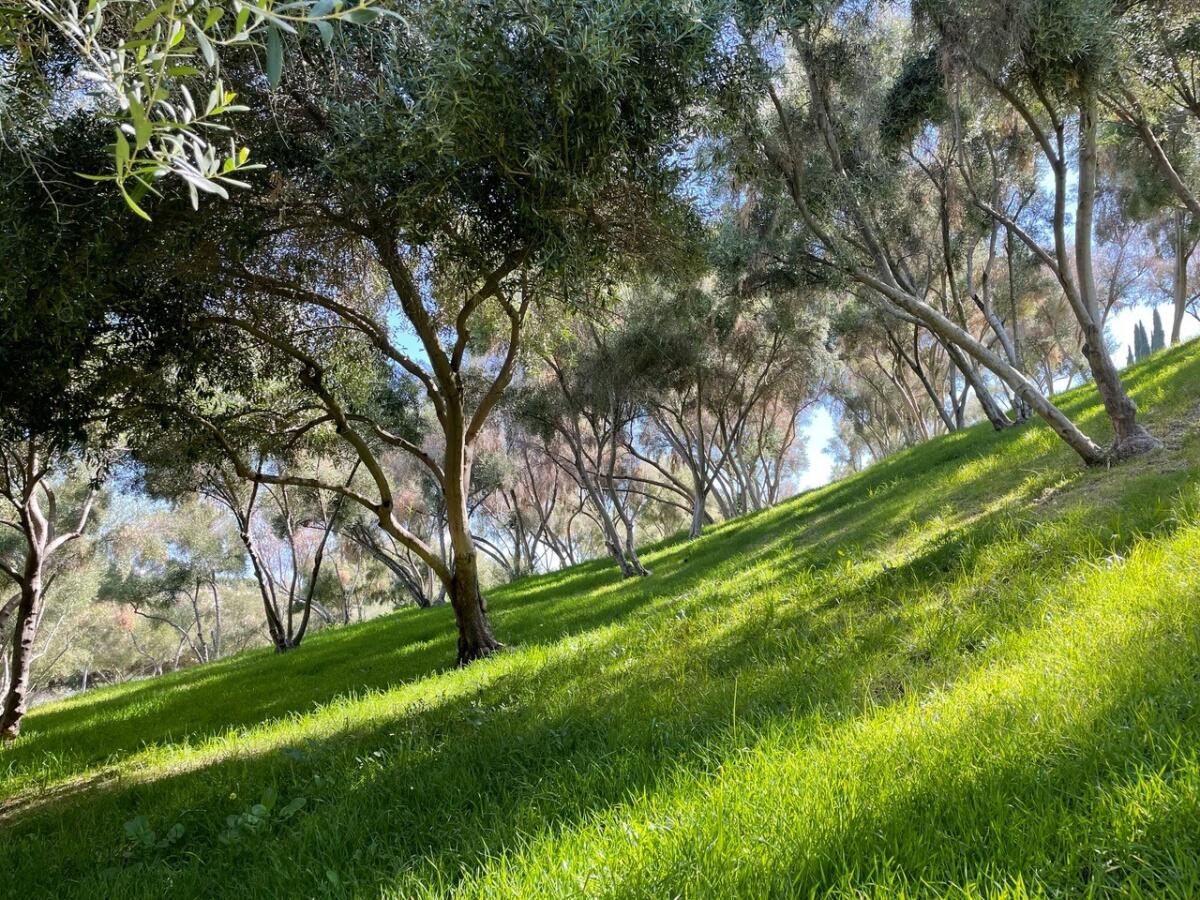
1,225. That’s the number of lush, fruit-bearing olive trees that once populated what’s now Barnsdall Art Park. 463? That’s what’s left.
Hi, I’m arts writer Deborah Vankin, filling in this week for Carolina A. Miranda, who’s having her own issues with trees lately. (See last week’s newsletter. Keyword: Claritin). But back to Barnsdall ...
East Hollywood gets a daily blast of fresh oxygen thanks to the existing olive trees clustered in a small grove on Barnsdall’s property, which also houses Frank Lloyd Wright’s Hollyhock House, the Los Angeles Municipal Art Gallery and the Gallery Theatre. But the 130-year-old grove, founded as a commercial orchard in the 1890s by real estate broker Joseph H. Spires, was once 25 acres larger. It was so bountiful and majestic — the trees, spaced 20 feet apart, blanketed the hillside — that the orchard stood in for Jerusalem’s Mount of Olives in D.W. Griffith’s 1916 silent film, “Intolerance.”
Oil heiress, arts lover and philanthropist Aline Barnsdall bought the property in 1919, hired Lloyd Wright to build her home there and gifted a portion of the property to the city of Los Angeles in 1927. But the grove shrank over time. After Barnsdall died, the property was subdivided. Commercial development, environmental factors and an aging irrigation system all contributed to trees dying off, one by one.

Why am I telling you all this? There’s now an ambitious effort underway to revitalize Barnsdall’s olive grove. It’s a partnership among the Barnsdall Art Park Foundation, the City of Los Angeles Department of Recreation and Parks and the Los Angeles Parks Foundation. And it involves nearly two dozen local artists, designers, architects and landscape architects who are spinning tree trimmings into art for an online auction and fundraiser running through Dec. 4.
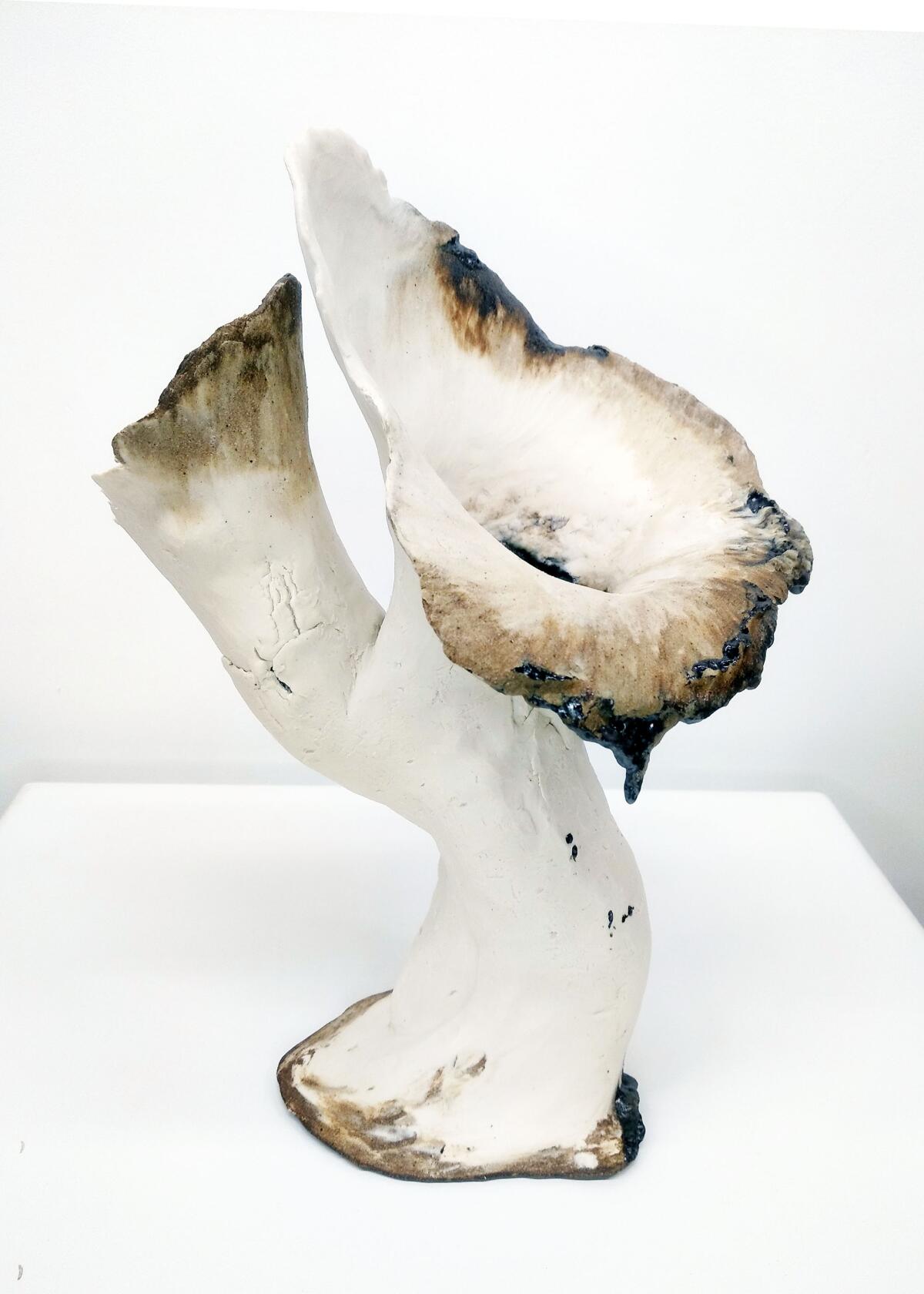
The goal is at once to raise funds to plant 40 new olive trees and to chart a course forward for their care and maintenance.
“We’re trying to transform it from an ailing condition to a vital, robust, beautiful landscape that’s as much a treasure for the community as the Hollyhock House or the art gallery,” says foundation President Daniel Gerwin. “And to be that, it needs to be taken care of.”
The project has its roots in the pandemic, so to speak. (Sorry, low-hanging fruit.) (Oops, another easy one.) When Barnsdall shuttered last year because of COVID-19, the Barnsdall Art Park Foundation saw an opportunity to do heavy landscaping work, Gerwin says, “so that when the gates do open again — as they are now — you’ll have this olive grove on the road to recovery, healthier and richer than ever.” (The park is now open, but the Hollyhock House, art gallery and theater are not.)
Environmental justice, Gerwin adds, was also top of mind. “The general area around Barnsdall is just a concrete jungle; there’s nothing there,” he says. “The environmental well-being of that community — air quality, temperature — is significantly affected by the health of the trees and the number of the trees.”
The Barnsdall Art Park Foundation kick-started the initiative by giving a $25,000 grant to the Los Angeles Parks Foundation’s Adopt-a-Park program; it, in return, oversaw the first phase of work on the grove. Work began in March with a forensic evaluation of the existing trees, many of which were browned and withering, and a sweeping, much-needed pruning was done.
The effort left behind piles of large, ragged tree limbs that normally would be ground into wood chips. Instead, artists — all part of the new Barnsdall Olive Wood Workshop exhibition and online auction — transformed the leftover wood into artworks now on view at the downtown L.A. gallery Luis De Jesus Los Angeles. The concurrent auction is accessible online.
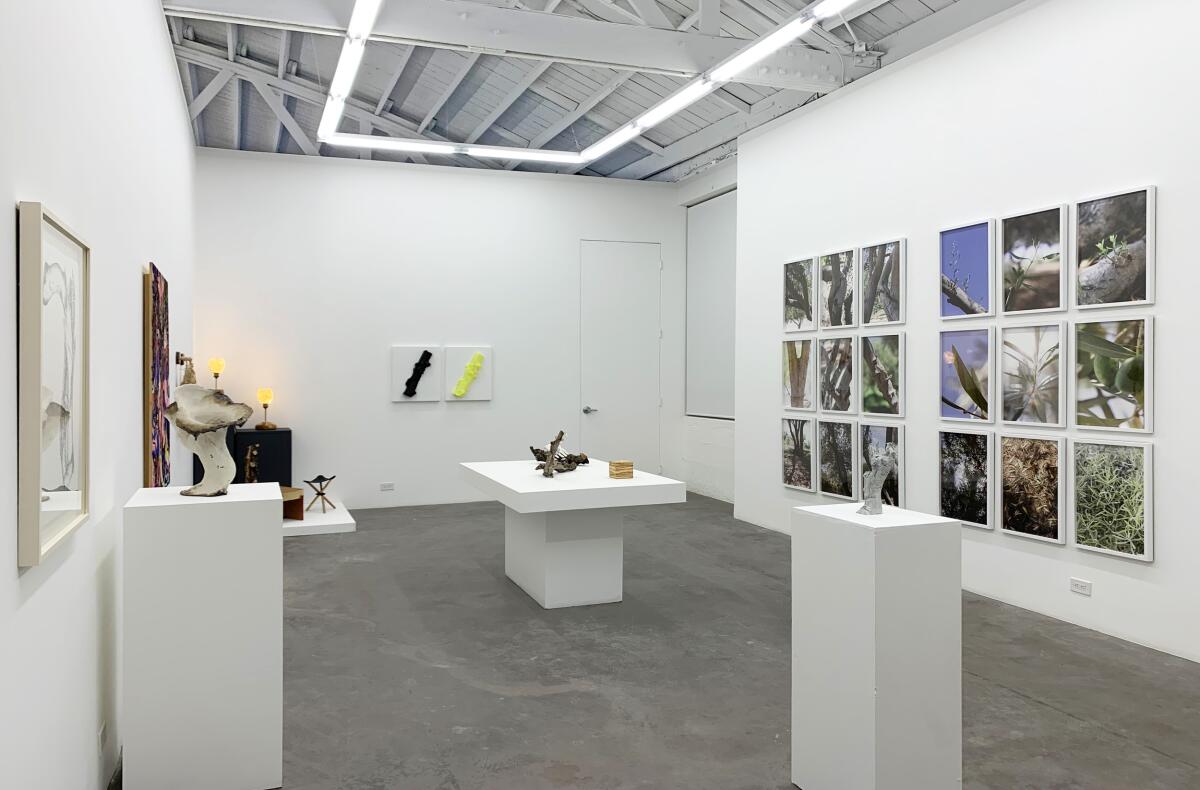
Among the participants: artists Kelly Akashi, Galia Linn, JPW3, Rosha Yaghmai, Kori Newkirk and Emily Sudd, as well as designers Jamie Bush and Azadeh Shladovsky. Net profits from the auction will be split among the artists and the grove revitalization initiative.
Some of the works in the exhibition are functional, such as the “Killspencer Anywhere Chair,” a portable stool with polished wooden legs and a hand-sewn bull-hide leather seat by Spencer Nikosey; or the “Olivewood Edison Lamp #02,” with its glowing, amber and green glass shade by Sevag Pakradouni of Sev’s Wood Crafts.
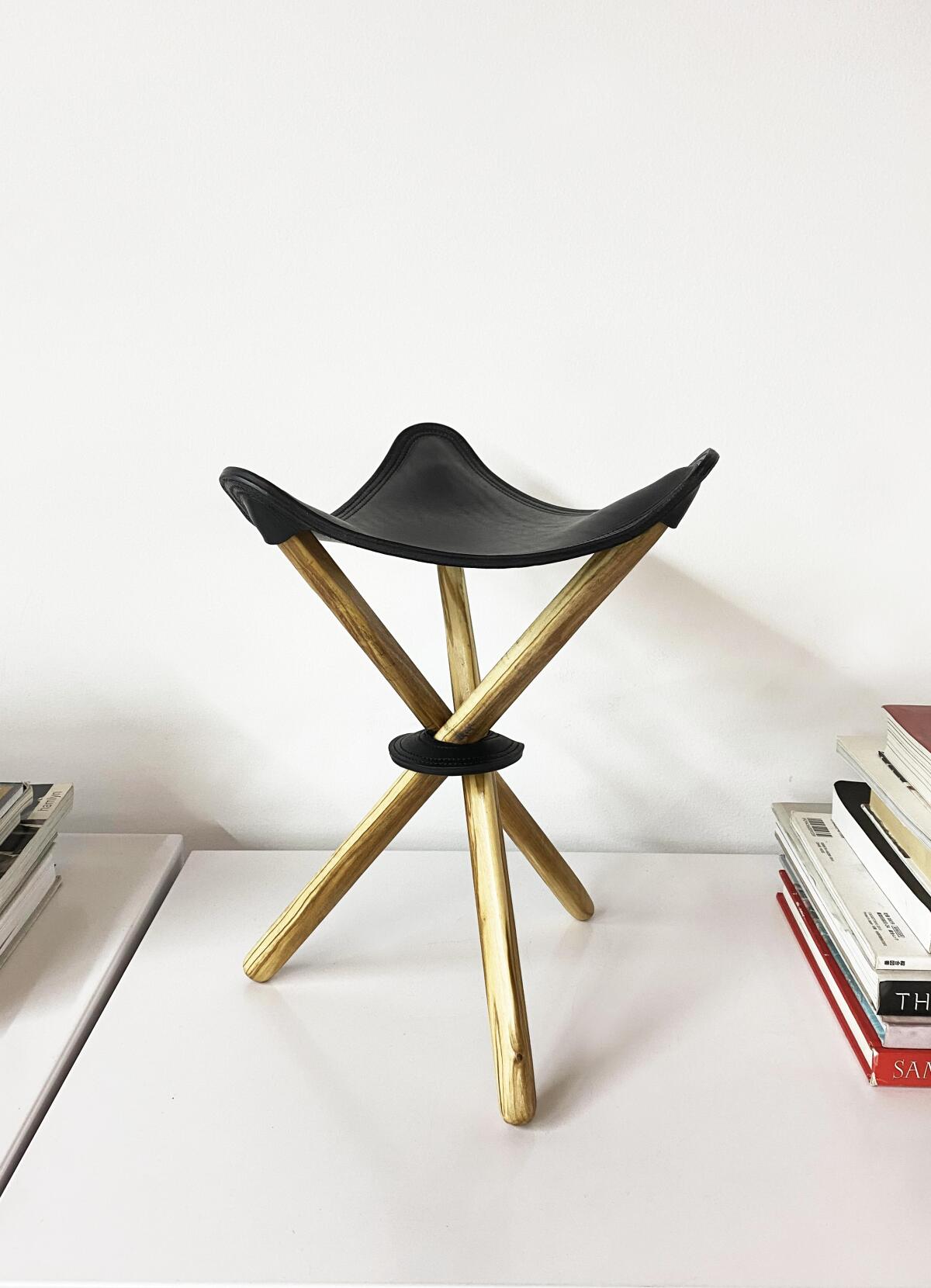
Others are more conceptual. For “Precious,” Linn placed a polished log in a small net that she wove; she attached dangling, handmade ceramic charms. The otherwise exposed log rests safely in its cradle.
Sarah Watlington’s “Box with the sound of its own making if we are to imagine the act of becoming as not a solitary endeavor but a complex web of interdependent relationships” is — not surprisingly — a tiny wooden box, 4 inches square, that houses sound. Inside are bits of audio from the park, recorded over a month, including rustling leaves, birds and laughter.
Others are personal. Sudd, a multimedia artist who works in ceramic sculpture, took a painting class at Barnsdall as a kid. For “Ghost Wood,” she wrapped her log with ceramic clay and molded it into a blooming flower. The base still holds the shape of the original log, a nod to her roots as an artist.
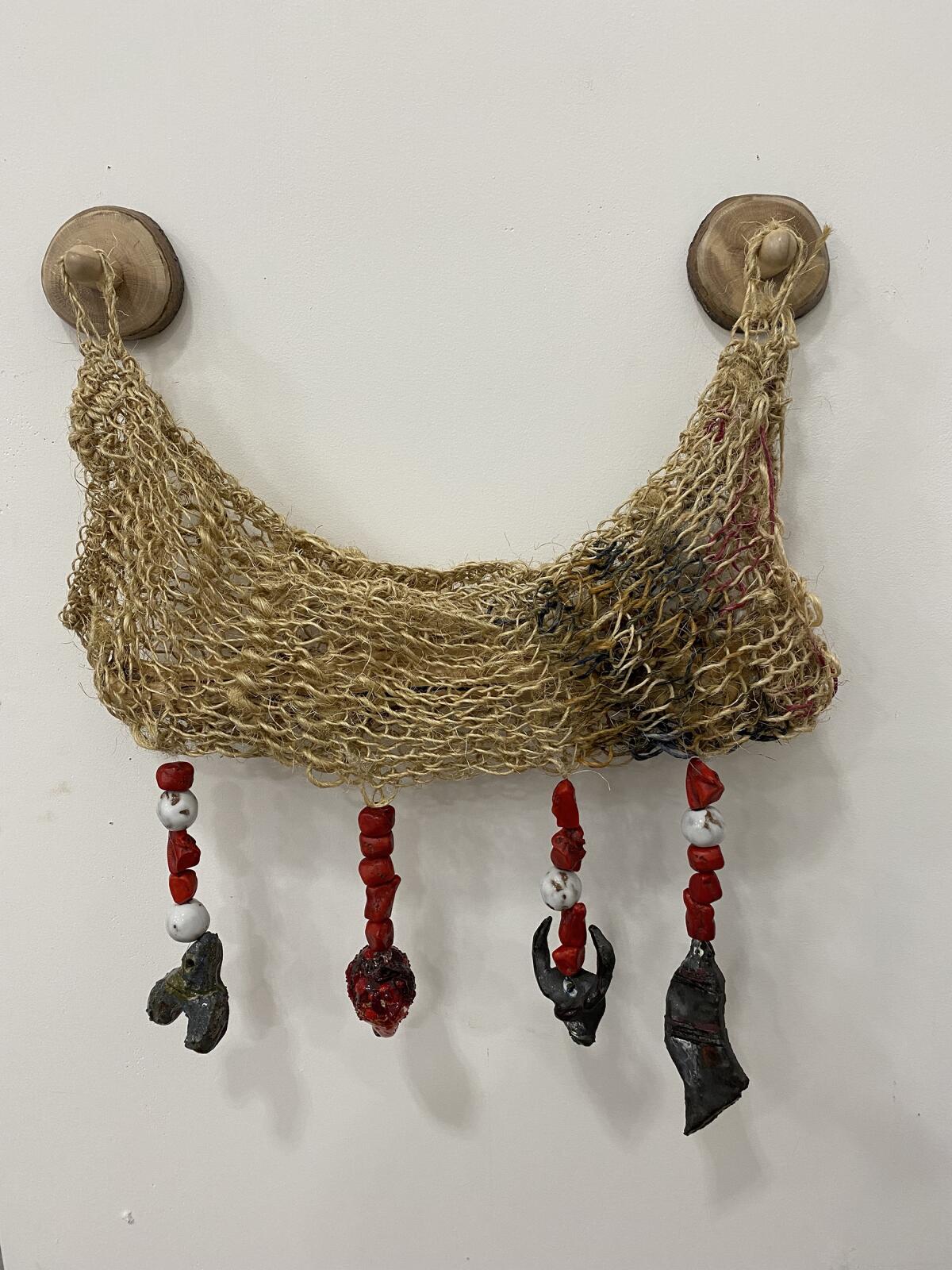
2021 has been a big year for Barnsdall: It’s the 100th anniversary of the Hollyhock House and the 50th anniversary of the art gallery and theater, as well as the 50th anniversary of Barnsdall Art Park’s landing a spot on the National Register of Historic Places.
But the olive grove revitalization, Gerwin says, is about moving forward, an effort to foster collective healing 21 months into the pandemic.
“Where you go to heal, you go back to Mother Earth,” Gerwin says. “Being around trees and grass and birds, it’s a restorative experience. The grove is a place to heal from COVID and the rigors of urban life.”
Now I’m going to hand the reins to my colleague Jessica Gelt, who will give you the rundown on what else is happening across the mind meld that is the L.A. arts scene.
Art report
The news this week is good enough to eat, as staff food writer Stephanie Breijo tucks into 5 things you need to know about Lulu, the new courtyard restaurant and bar at the Hammer Museum. The eatery is a collaboration between famed farm-to-table progenitor Alice Waters and former Chez Panisse head chef David Tanis. Waters, who founded Berkeley’s Chez Panisse and has worked with Tanis for years, is known for her devotion to seasonality and local farms. Lulu will embrace a similar concept, but it is Tanis, not Waters, who is taking the lead, Breijo writes.
“I’ve never wanted to have another restaurant — and I don’t have another restaurant,” Waters said. “I am cheerleading for a restaurant that I think is very important to have at the Hammer Museum.”
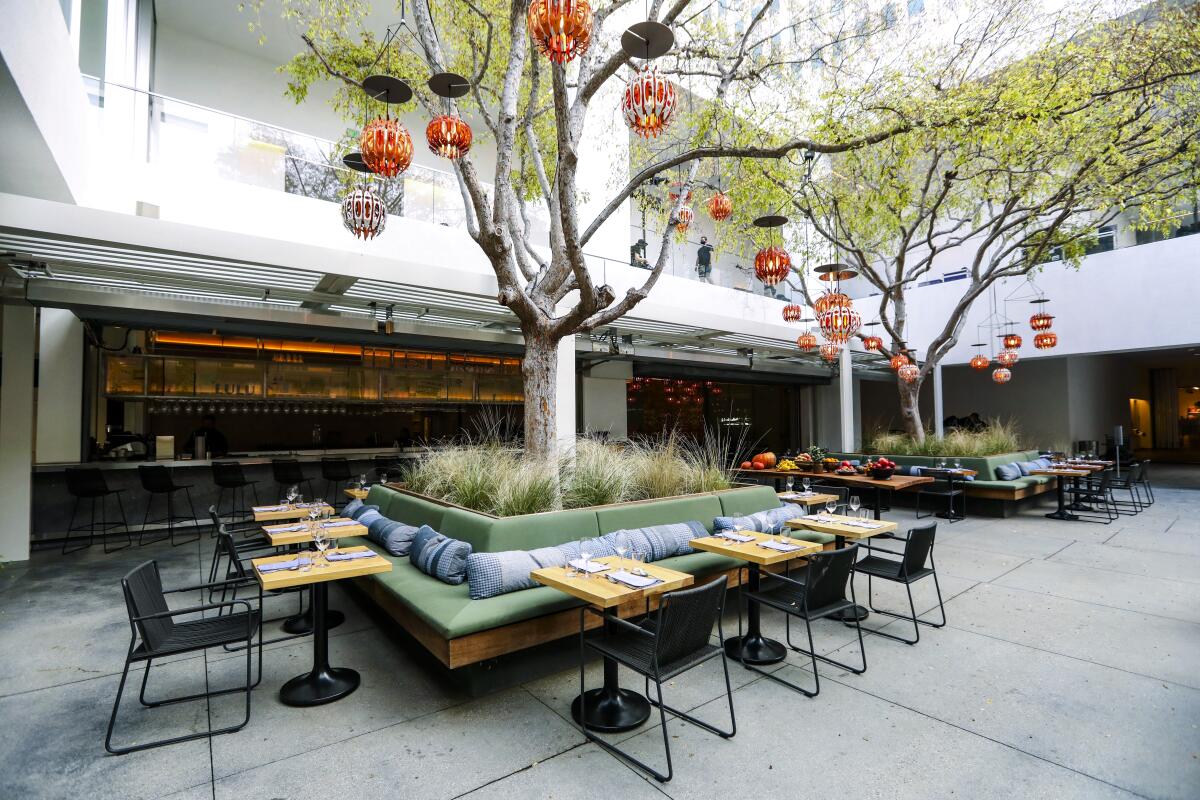
Make the most of L.A.
Get our guide to events and happenings in the SoCal arts scene. In your inbox once a week.
You may occasionally receive promotional content from the Los Angeles Times.
On and off the stage
The movie musical is experiencing a comeback, with a cornucopia of up-and-coming offerings for fans including Steven Spielberg and Tony Kushner’s take on “West Side Story,” Lin-Manuel Miranda’s “Tick, Tick ... Boom!” and Peter Dinklage in “Cyrano” landing before year’s end. Also on the horizon: the animated musicals “Encanto” from Disney and Universal’s “Sing 2.”
This pleasing state of plenty prompted Times film critic Justin Chang and theater critic Charles McNulty to sit down to discuss the universal appeal of people breaking out in song and what that means for the modern movie musical.

Live theater continues to reopen, and social justice and the exploration of racism are front and center at Skylight Theatre in a co-production with Playwrights’ Arena called “A Hit Dog Will Holler.” Written by Inda Craig-Galván, and directed by Playwrights’ Arena‘s artistic director, Jon Lawrence Rivera, the play takes place in February 2020 and, as theater critic McNulty writes in his review, “examines the private toll on two Black women who are in the trenches in the war against racial injustice.”
The Pasadena Playhouse is celebrating its reopening, writes McNulty in a review, with a party rather than a play. The venue’s anticipated return to live theater features a “radically transformed” version of the Broadway Go-Go’s musical “Head Over Heels.” The inside of the theater has been decked out to resemble an ’80s nightclub, and the audience is invited to join the performers as they dance on the main floor.

Earlier in the week, reporter Ashley Lee explored “Head Over Heels” from another angle as she detailed how the exuberant show defies pre-pandemic theater rules. A dancing audience that is also invited to sing along loudly signals a shift from the experience of passively sitting and watching a show unfold.
“These scrappy touches are a way to lean into the playfulness of us all being back in a room together,” says Jenny Koons, who directed, choreographed and conceived the production with Sam Pinkleton.
Speaking of musicals, Lee this week also shone a spotlight on the evolution of Lin-Manuel Miranda’s “Tick, Tick ... Boom!” which was originally conceived as one-man show and later reconfigured into a three-actor production, then a major Netflix release starring Andrew Garfield.
Finally, the experimental opera company the Industry is back with its first live show since the start of the pandemic. “Hive Rise,” an immersive sound experience, is being staged at the Geffen Contemporary at MOCA. It is choreographed and directed by Lilleth and composed and performed by sonic artist Ash Fure, who in June joined the Industry as a co-artistic director alongside company founder Yuval Sharon and Malik Gaines.
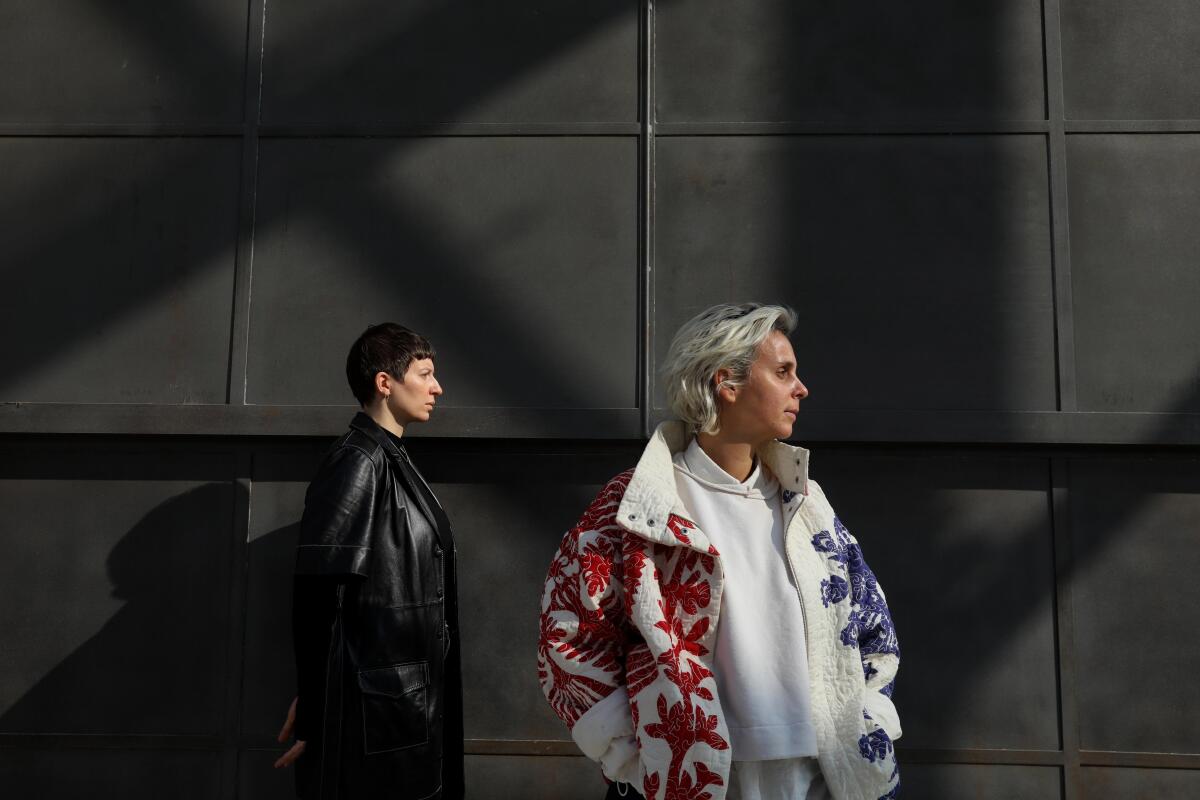
I recently sat down for a talk with Lilleth and Fure, who went into detail about how sound — without words — can become the ultimate collective experience.
Classical notes
Patrons of Walt Disney Concert Hall got a treat last week when Greek violinist Leonidas Kavakos and star Chinese pianist Yuja Wang appeared together in a program of violin sonatas by Bach, Busoni and Shostakovich. In his review, classical music critic, Mark Swed, wrote about how the tradition of giving the pianist second-billing in such recitals feels outdated, especially when it comes to Wang, whose name on the bill, Swed noted, likely sold more tickets than Kavakos.

Enjoying this newsletter? Consider subscribing to the Los Angeles Times
Your support helps us deliver the news that matters most. Become a subscriber.
Design time
Back when print reigned supreme, Los Angeles was home to a vibrant newspaper ecosystem, and The Times had competition, including from William Randolph Hearst’s Herald Examiner, which was located in a lavish Mission Revival-style structure completed in 1914 by Julia Morgan — the first woman licensed to practice architecture in California.
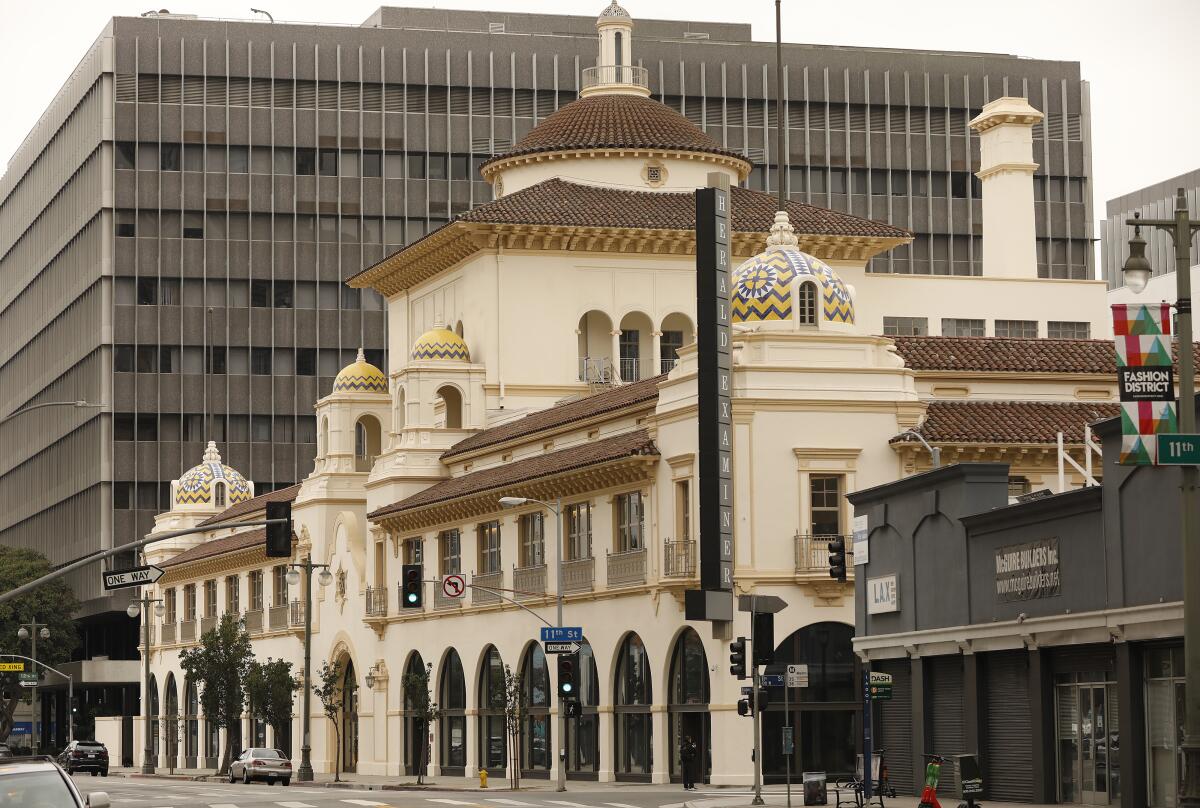
L.A. has a dismal track record when it comes to historic preservation, and for quite some time the building — downtown at Broadway and 11th Street — was slated to be razed to make way for a parking lot. Fortunately, the ignoble fate did not come to pass, and the structure has now reopened as a learning center for Arizona State University.
Newsletter maven and Times arts, architecture and urban design columnist Carolina A. Miranda took a look at the reimagined building. She found that developers at Georgetown Co. and a team of architects at Gensler “have lovingly revived this gracious structure. This has included tending to decades of deferred maintenance and dealing with unsympathetic additions.”
Essential happenings
The ever-diligent Matt Cooper has compiled a list of some of the best arts happenings around town for the coming week. They include a performance at the Soraya by Martha Graham Dance Company with musical accompaniment by Wild Up; a set of six choreographed works by Parsons Dance company founder David Parsons at Segerstrom Center for the Arts, and the West Coast premiere of playwright Dominique Morisseau’s drama “Paradise Blue” at the Geffen Playhouse.
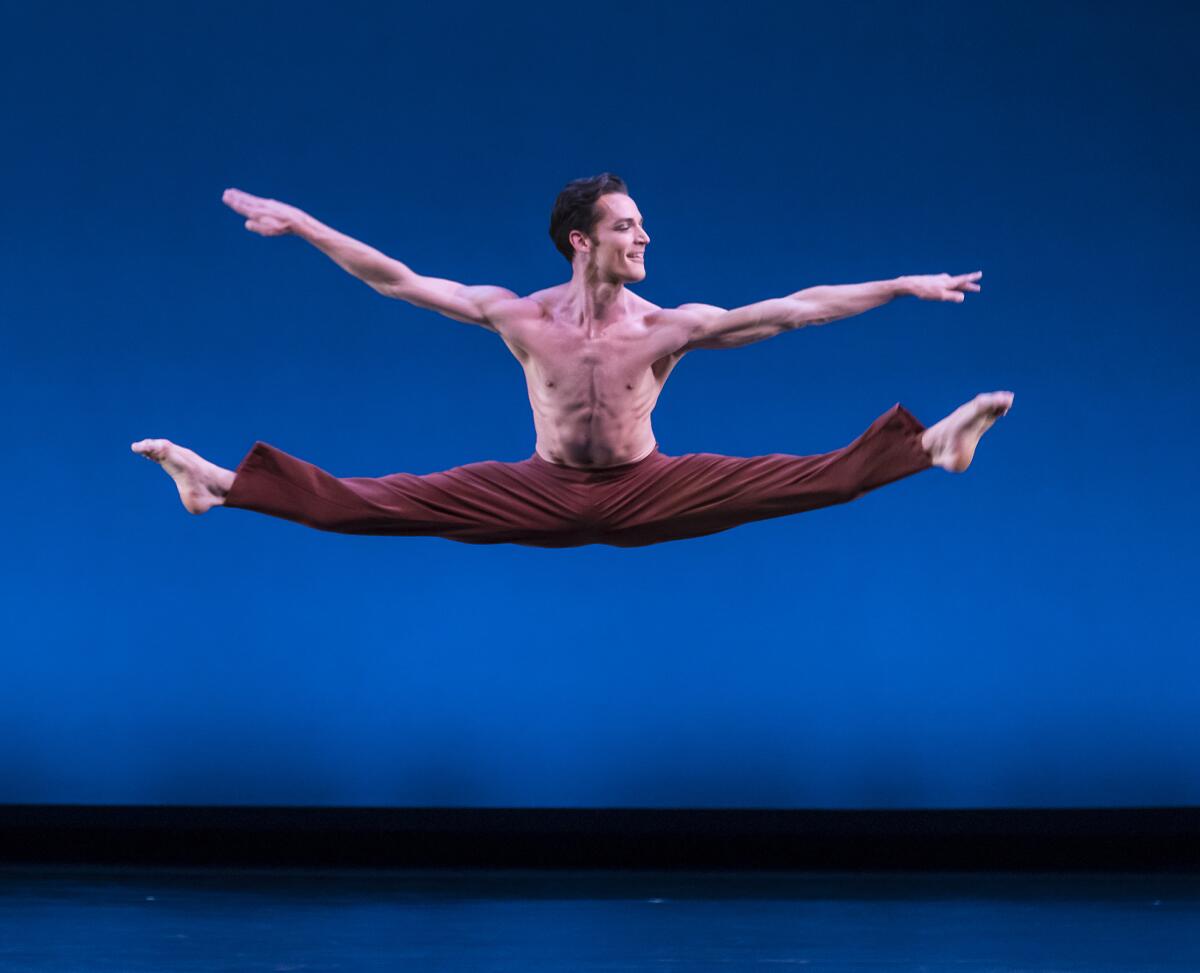
Passages
Artist Jimmie Durham, known for incorporating Native American imagery into his untraditional sculptures, has died at 81. Durham was widely celebrated until a debate about his claim to Cherokee ancestry raised questions about his intentions. In 2017, The Times’ art critic, Christopher Knight, reviewed a comprehensive exhibition of Durham’s work at the Hammer Museum and found the sprawling display of more than 200 works to be a “bracing event.” Shortly after that retrospective a group of Cherokee artists, writers and scholars published an opinion piece questioning Durham’s connection to the Cherokee tribe.
In other news
—The California African American Museum has named Essence Harden its visual arts curator. With the hire, CAAM Executive Director Cameron Shaw has placed five Black women in top leadership and curatorial roles, including Isabelle Lutterodt, who was brought in as deputy director a few weeks ago.
—L.A. artist Tanya Aguiñiga has been awarded the $250,000 Heinz Award along with artist Sanford Biggers. Aguiñiga, a fiber artist, took a hard knock when the pandemic caused the closure of her February 2020 solo exhibition at Pasadena’s Armory Center for the Arts.
—A new documentary titled “A Choice of Weapons: Inspired by Gordon Parks” has debuted on HBO. It explores the groundbreaking photographer’s legacy and focusses specifically, writes Deborah Vankin, “on the generation of photographers, activists and artists that he inspired.” As the first Black photographer hired to shoot for Life magazine, Parks’ stunning, candid imagery, shot from the late ’40s through the early ’70s, set a high bar for photojournalism.
And last but not least ...
My 13-year-old stepdaughter has decided she is keen to become an actress, so we are taking Zoom tours of L.A.-area arts high schools, and I gotta say, Los Angeles County High School for the Arts (LACHSA) takes the cake. This tuition-free public school is located on the campus of Cal State L.A., and students have access to many of the university’s arts buildings, as well as its library and food court. The arts training is conservatory-style, and the competition to get in seems stiff. But it was enough to make me want to go back to school, just to have the privilege of mingling with the amazing up-and-coming artists that LACHSA seems to attract.
The biggest entertainment stories
Get our big stories about Hollywood, film, television, music, arts, culture and more right in your inbox as soon as they publish.
You may occasionally receive promotional content from the Los Angeles Times.


